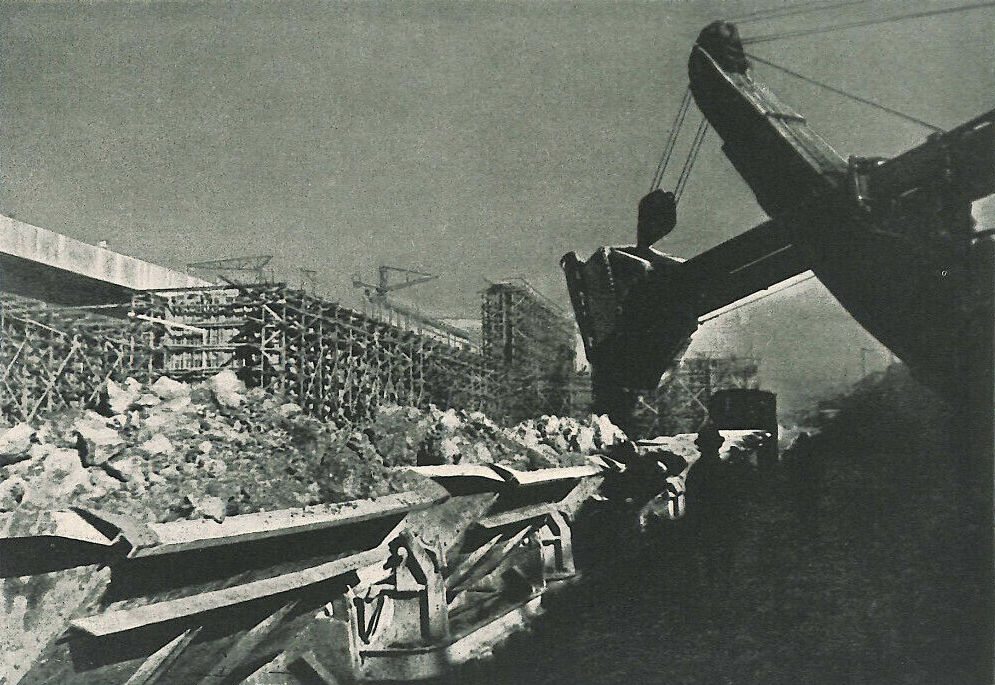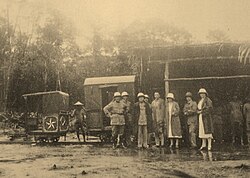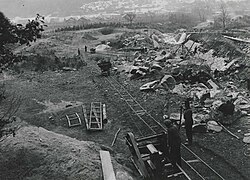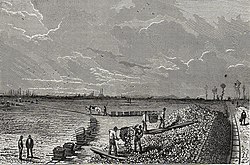La construction d'une base sous-marine - Des wagonnets attelés à une locomotive Decauville apportent au chantier les matériaux de construction (L'Illustration, 1er Mai 1943, p. 258, cropped)
THE CONSTRUCTION OF A SUBMARINE BASE Of all the devices born of modern warfare, the submarine is one of those that the public knows the least for lack of having been able to see it in action. It therefore only speaks to the imagination through official communiqués. The obligation for the foreign powers to cross the sea to attack Europe assigns to the submersible a role of the utmost importance. The development and duration of the war depended to a very large extent on it. To be convinced of this, one need only recall the danger that German submersibles posed to Great Britain in 1917, at the time the United States entered the war. The extent of this peril was not known until long afterwards, when it was revealed that the exact figures of British maritime losses at that time far exceeded those which the British Admiralty had recorded in its official statistics.
Admiralty had recorded in its official statistics. Even in the First World War, Germany had only a relatively small number of submarine bases. Since the beginning of the present war, the Reich's naval programme has greatly increased the number of submarines in its fleet, which already numbered several hundred.
As this fleet multiplies, the number of submarine bases and shelters must be increased proportionally. Since the German occupation of the European coastline from the North Cape to the Bay of Biscay, the Todt Organisation has dotted the Atlantic coast with them. These bases being, by their use, targets of choice for the opposing aviations, their superstructures had to be resistant to the strongest bombs. We can say, by schematising their plans, that they are tunnels protected by several layers of reinforced concrete. The submarines slip in and out of these artificial caves like dolphins in a cove.
The construction of these shelters and the earthworks for their holds required the temporary establishment of a land-based construction site on a part of the sea front where the water was several metres deep. The site of these yards was circumscribed with metal sheet piles driven into the seabed with a ram. The water was then removed by means of powerful motor pumps, the piping of which is shown in one of our images. The sea was driven out of this enclosure for the duration of the work and the workers took their place. The rock was attacked with dynamite or pneumatic drills. Steam excavators scoured the mud or sand. A first clearing was done with trucks until a Decauville railway could be laid on the levelled ground. Our cover photograph shows one of these sites at this stage of the clearance work. Once the rubble had been removed, the ground was cemented and the cradles, docks and basins needed to park, maintain or repair the submarines were built.
The pictures opposite show the different phases of the construction of a submarine base: erection of the scaffolding, the formwork in which the cement is poured, and the placing by workers - in this case Moroccans - of the steel bars that form the cement armour of the superstructures.
Finally, with the work completed, the sea was given free access to the submarine nests by blowing up the watertight barrier that had protected the site during the work.
L'ILLUSTRATION 1er Mai 1943Relevante Bilder
Relevante Artikel
DecauvilleDie Maschinen- und Lokomotivfabrik Decauville [dəkovil] war ein französischer Industriebetrieb in Corbeil, der durch seine Feldbahnsysteme bekannt wurde, mittlerweile ist Decauville SAS nur noch Nutzfahrzeughändler. Die Tochterfirma Société des Voitures Automobiles Decauville stellte von 1898 bis 1910/1911 auch Automobile her. .. weiterlesen










































